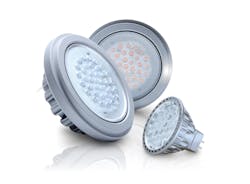Ecosense acquires Soraa brand, lamp portfolio, IP, and assets
Ecosense has announced the acquisition of Soraa including the company’s assets, brand, product lines, intellectual property (IP) portfolio, and more. Soraa will continue to operate as an independent brand, but the deal puts Ecosense into the commercial lamps sector for the first time. Still, the motivation for the deal may come down to solid-state lighting (SSL) disinfection systems.
Our staff had an inkling that something was happening with Soraa as we have been unable to get response from the company in recent weeks. Still, we were surprised to see the company acquired by Ecosense. The high-end Soraa lamp products may be symbiotic with Ecosense SSL products. But Soraa has gone to an extreme in developing its product line starting with the development of a proprietary gallium-nitride-on gallium-nitride (GaN-on-GaN) LED architecture that has yielded arguably better performance and color rendering at the cost of R&D, more expensive substrates or wafers, and the supply chain expenses of using essentially proprietary LEDs.
Soraa launched from stealth mode at Strategies in Light 2012 with great fanfare, flush with venture funding and LED pioneer Shuji Nakamura as a co-founder. A presentation at the conference that year positioned Soraa as an LED manufacturer using the homogeneous GaN approach. But the company also demonstrated MR16 lamps to prove out its claims of superior color rendering. And the company quickly transitioned to a business model as a lamp manufacturer using the proprietary LED technology. The company expanded into the luminaire market in 2016.
The company has expanded its portfolio to not just include SSL products with superior color rendering but also products for other niches such as lighting for health and wellbeing in the Healthy series. That family features a blue-free spectrum while still rendering colors accurately.
Ecosense has said that Soraa will continue to operate as an independent brand under Ecosense management. “This acquisition accelerates our strategy into the next wave of lighting,” explains Mark Reynoso, CEO of Ecosense. “Soraa has an unparalleled reputation for beam and spectral quality. Their intellectual property and technology portfolio — including Zeroblue, full spectrum, and Healthy lighting — highly complements our own intellectual property and related technologies.”
As we rushed to get this article posted on our website, we had asked Reynoso about how Ecosense will handle the proprietary Soraa LED technology. We had not received answers when we posted the article, but may update the article upon receiving additional details.
Meanwhile, Soraa turned to co-founder Nakamura for a quote on the deal. “Soraa is a pioneer in full spectrum and circadian lighting,” said Nakamura. “Combining with Ecosense, we significantly expand our leadership and intellectual property rights in these and related fields. We are excited about our next phase of growth together.”
Those statements sound typical of the boilerplate included in merger & acquisition (M&A) press releases. Generally, however there is some other underlying impetus to any given deal that isn’t immediately evident.
In the Ecosense acquisition of Soraa, the release includes what could almost be a throwaway line in the Reynoso quote that just might have been the motivation of the deal. Reynoso added, “We will prioritize enhancing and accelerating their antibacterial technology to market.”
As we have written on a recurring basis, LED lighting in the violet region and in the very upper portion of the ultraviolet (UV) band can kill pathogens over lengthy periods of exposure. We just ran an article a few weeks ago on a GE Current project in the area.
The proprietary Soraa LED technology utilizes a violet emitter as opposed to the more typical blue pump used in phosphor-converted white LEDs. Soraa has said that the violet pump makes whites look brighter under Soraa LEDs. But those LEDs could also be utilized to kill pathogens such as the coronavirus.
The issue Ecosense will have, however, is one of IP for the disinfection application. As we have written before, there have already been court skirmishes as to who holds the prevailing IP edge in the application.

Maury Wright | Editor in Chief
Maury Wright is an electronics engineer turned technology journalist, who has focused specifically on the LED & Lighting industry for the past decade. Wright first wrote for LEDs Magazine as a contractor in 2010, and took over as Editor-in-Chief in 2012. He has broad experience in technology areas ranging from microprocessors to digital media to wireless networks that he gained over 30 years in the trade press. Wright has experience running global editorial operations, such as during his tenure as worldwide editorial director of EDN Magazine, and has been instrumental in launching publication websites going back to the earliest days of the Internet. Wright has won numerous industry awards, including multiple ASBPE national awards for B2B journalism excellence, and has received finalist recognition for LEDs Magazine in the FOLIO Eddie Awards. He received a BS in electrical engineering from Auburn University.





